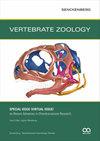重游中美洲:新的采样问题对分类和分布的当前认识(动物目:蝶科)
IF 2.3
2区 生物学
Q1 ZOOLOGY
引用次数: 0
摘要
利用3226 bp长的mtDNA序列和5个核位点(cmo、ODC、R35、Rag1、Rag2,共3409 bp),研究了中美洲滑龟(Trachemys grayi, T. venusta)的遗传分化和亲缘关系。我们的调查还包括来自北美特有的分类群(gaigeae、scripta)、安的列斯群岛(decorata、decussata、stejnegeri、terrapen)和南美洲(dorbigni、medemi和南美洲北部特有的两个venusta亚种)的样本。我们的线粒体系统发育检索了所有被研究的物种,在一个多分类学中有三个得到良好支持的分支:(1)中南美洲物种(T. grayi + T. venusta) + (T. dorbigni + T. medemi),(2)安的列斯物种,(3)T. gaigeae + T. scripta。我们的核DNA分析还显示了三个不同但相互冲突的类群:(1)scripta加安的列斯物种,(2)gaigeae,以及(3)中美洲和南美洲的T. dorbigni, T. grayi, T. medemi和T. venusta。然而,在线粒体系统发育中,gaigeae是T. scripta的小分化姐妹分类单元。这种相互矛盾的位置表明了不同的进化轨迹和与scripta的古老杂交以及线粒体捕获。尽管灰衣T. gray和黄衣T. venusta在颜色模式上存在显著差异,但遗传差异较浅,并且每个物种的分类多样性与目前已知的几个亚种可能被高估。最后,我们首次提供了沿哥斯达黎加的加勒比海地区的T. grayi发生的证据。本文章由计算机程序翻译,如有差异,请以英文原文为准。
Central American Trachemys revisited: New sampling questions current understanding of taxonomy and distribution (Testudines: Emydidae)
Using 3226-bp-long mtDNA sequences and five nuclear loci (Cmos, ODC, R35, Rag1, Rag2, together 3409 bp), we examine genetic differentiation and relationships of Central American slider turtles (Trachemys grayi, T. venusta). Our investigation also included samples from taxa endemic to North America (T. gaigeae, T. scripta), the Antilles (T. decorata, T. decussata, T. stejnegeri, T. terrapen), and South America (T. dorbigni, T. medemi plus the two T. venusta subspecies endemic to northern South America). Our mitochondrial phylogeny retrieves all studied species as distinct, with three well-supported clades in a polytomy: (1) the Central and South American species (T. grayi + T. venusta) + (T. dorbigni + T. medemi), (2) the Antillean species, and (3) T. gaigeae + T. scripta. Our nuclear DNA analyses also suggest three distinct but conflicting clusters: (1) T. scripta plus the Antillean species, (2) T. gaigeae, and (3) the Central and South American species T. dorbigni, T. grayi, T. medemi, and T. venusta. However, in the mitochondrial phylogeny, T. gaigeae is the little divergent sister taxon of T. scripta. This conflicting placement of T. gaigeae suggests a distinct evolutionary trajectory and old hybridization with T. scripta and mitochondrial capture. Despite prominent color pattern differences, genetic divergences within T. grayi and T. venusta are shallow and the taxonomic diversity of each species with several currently recognized subspecies could be overestimated. Finally, we provide for the first time evidence for the occurrence of T. grayi along the Caribbean versant of Costa Rica.
求助全文
通过发布文献求助,成功后即可免费获取论文全文。
去求助
来源期刊

Vertebrate Zoology
ZOOLOGY-
CiteScore
4.00
自引率
19.00%
发文量
42
审稿时长
>12 weeks
期刊介绍:
Research fields covered by VERTEBRATE ZOOLOGY are taxonomy, morphology, anatomy, phylogeny (molecular and morphology-based), historical biogeography, and palaeontology of vertebrates.
 求助内容:
求助内容: 应助结果提醒方式:
应助结果提醒方式:


